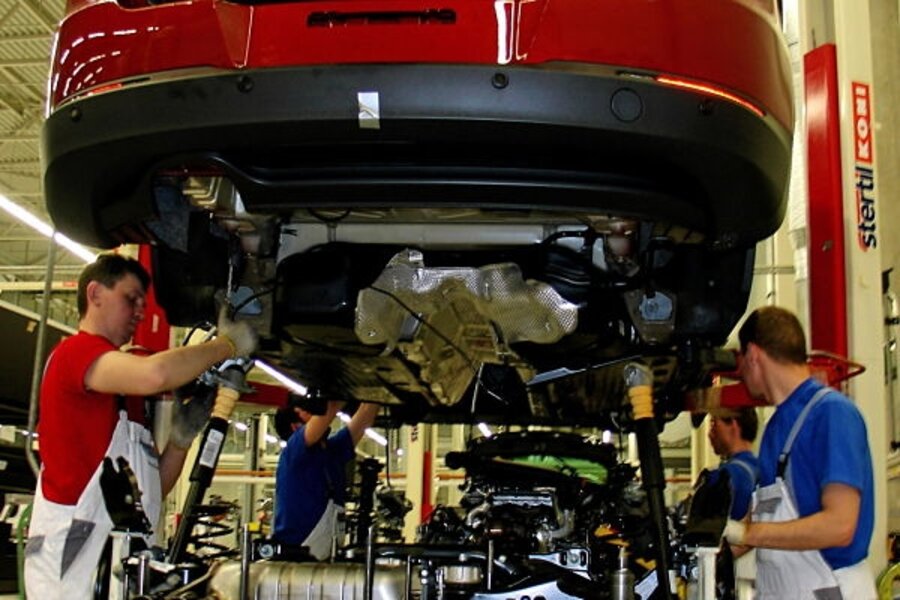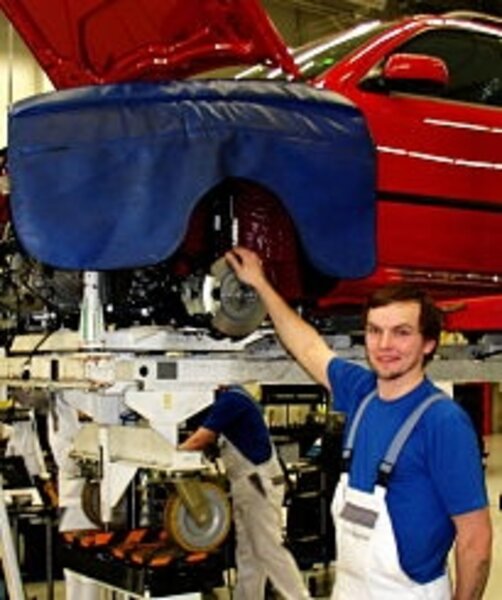Global crisis aside, foreign carmakers flock to Russia
Loading...
| Kaluga, Russia
People are starting to call this central Russian industrial town “Little Detroit.” Unlike its American namesake, the car factories here are not only still working, but they’re going forward with ambitious expansion plans.
Russia already has a home-grown auto industry, but the new factories are distancing themselves from the clunky Soviet days – meaning experienced Russian auto workers need not apply. Wages are even less than those at auto plants in Eastern Europe, but the sour economy is resulting in an abundance of eager labor.
Amid Russia’s skyrocketing interest rates, plunging ruble, and rising unemployment, Kaluga is proving to be a rare bright spot.
A two-year old Volkswagen plant just outside Kaluga, which assembles Passat and Jetta sedans for Russia’s fledgling middle class, has slashed weekly shifts in half, though it has not yet laid-off any workers.
Foreign production up
Volkswagen claims that it has sold more cars in Russia this January than in the same month last year. A sprawling Volvo truck plant opened production near Kaluga in January. Peugeot Citroën and Mitsubishi will break ground later this month for a joint production facility that could be churning out 300,000 vehicles by 2012. Local officials say that the Canadian car-parts maker, Magna, will finalize a deal this week to build a factory near Kaluga’s burgeoning “auto industry cluster.”
They’re all attracted to Russia’s auto market, which, despite red-hot growth in recent years, still has just 250 cars per 1,000 people, compared with nearly 500 per 1,000 people in the US and Western Europe.
As Russia’s indigenous auto industry stumbles, amid plant shutdowns and sagging sales for its cheap but widely despised Soviet-era models, foreign automakers still smell opportunity. Recent Kremlin decisions to raise tariffs on imported cars and to support consumer lending for domestically produced brands have boosted incentives for them to locate in Russia.
“We’re in this for the long haul, because we believe the Russian market is strong despite the current downturn,” says Dietmar Korzekwa, VW’s general director for Russia. “We are hopeful that during this present crisis we can win greater market share.”
Fastest-growing market
Russia was the world’s fastest-growing automobile market in 2008 with sales of over 3 million new cars, only half of which were domestically produced, according to a report by the consultancy
PricewaterhouseCoopers. Even though the market is expected to shrink by up to 50 percent this year, Russia-based carmakers could actually maintain or increase their sales thanks to the government’s protectionist measures and the falling ruble, it says.
The Kaluga VW plant currently assembles cars from modules imported from Germany, Mexico, and the Czech Republic, but a huge construction site next to its present plant testifies to its commitment to fully produce its automobiles in Russia by the end of 2011.
Mr. Korzekwa says VW chose to set up in Kaluga because the city of 350,000 people, some 125 miles south of the giant Moscow market, has good infrastructure, skilled labor, and a business-friendly local administration. Another factor, he suggests, was that the city has no past association with the former Soviet auto industry, with its legacy of poor design, awful work habits, and disastrous quality control.
“With our (mostly young) new workers, the approach is training, training, control, control,” he says. “It’s most important that we have nobody here who’s ever built cars in Russia before. It was one good reason for coming to Kaluga.”
Lower-paid workers
Wages here are much lower than at comparable plants in Eastern Europe, or even Moscow, but assembly-line workers profess to be happy. “A lot of people would like to work here, but it isn’t easy to get in,” says Ilya Ivlev, who’s worked at VW for nine months now. “You hear a lot about the economic crisis, but this job seems to be good.”
Thanks largely to the influx of foreign automakers, the Kaluga region saw 35 percent industrial growth last year, far above the overall Russian rate of 3.5 percent. That isn’t likely to hold this year, as many of its Soviet-era industries – especially machine-building – are hurting badly amid the general crisis.
“A lot of factories around here have closed, slashed their workweek, cut salaries, or put workers on unpaid leaves,” says Yury Rastorguyev, editor of Kaluga’s main daily newspaper, Vest. “But we seem to be getting along better than some of our neighboring regions.”
Will Ladas survive?
Experts say the crisis may accelerate the end of Russia’s indigenous auto industry, which has largely failed to improve quality or introduce new models, despite years of state investment and joint ventures with foreign automakers. Lower prices – around $10,000 for a new Lada, compared with $30,000 for a VW Passat – may have slowed their decline, but few owners of traditional Russian brands such as Lada, Volga, or Niva express any satisfaction with their cars.
“Foreign cars, even those made in Russia nowadays, are far better and safer than our traditional Russian ones,” says Pavel Kurchavy, a professional driver. “I don’t know anyone who would prefer to buy a Russian car.”
New customs tariffs of up to 25 percent on imported vehicles should have boosted sales, and Russian-made cars should have benefited from the plunging ruble, which has lost about 40 percent of its value since last September. Nevertheless, Russia’s biggest automaker, AvtoVaz, last week announced an indefinite shutdown of its main assembly plant in Togliatti, on the Volga River, amid reports that it holds a huge backlog of unsold cars and has been unable to pay suppliers.
“The Russian car industry has been losing market share ever since foreign models began appearing here,” says Anatoly Leyrikh, a council member of Delovaya Rossiya, a private business association.” Five years ago, traditional Russian brands held 85 percent of the market; now they have barely a quarter of it.
Western carmakers will bury Russian ones unless they find the means to build a totally new product.”
All of Russia’s “Big Three” automakers are in trouble, says Sevastyan Kozitsyn, an expert with BrokerCreditService, a Moscow-based financial services firm.
Debt-laden carmakers
The giant Gaz factory complex in Nizhni Novgorod, which produces Volga sedans and Gazel vans, is saddled with debt and “about 80 percent of its shares have been pawned to a big Russian bank,” he says. AvtoVaz, which builds lighter cars, is facing massive debts and a 30 percent drop in demand for its cars. Only the truckmaker, Kamaz – though suffering – looks able to survive without major state support, he adds.
When the crisis finally abates, it’s possible the Russian auto industry will still be alive, but its geographical center will have shifted from the Volga to the new facilities springing up here in Kaluga. And those old Soviet brands may have given way to names familiar the world over, including VW, Volvo, and Citroen.
“We have a lot of optimism about our carmakers,” says Ruslan Zalivatsky, head of the Kaluga regional government’s investment department. “Even though no one knows where the bottom of this crisis will be, they are still coming and setting up shop here. We’re very hopeful.”






